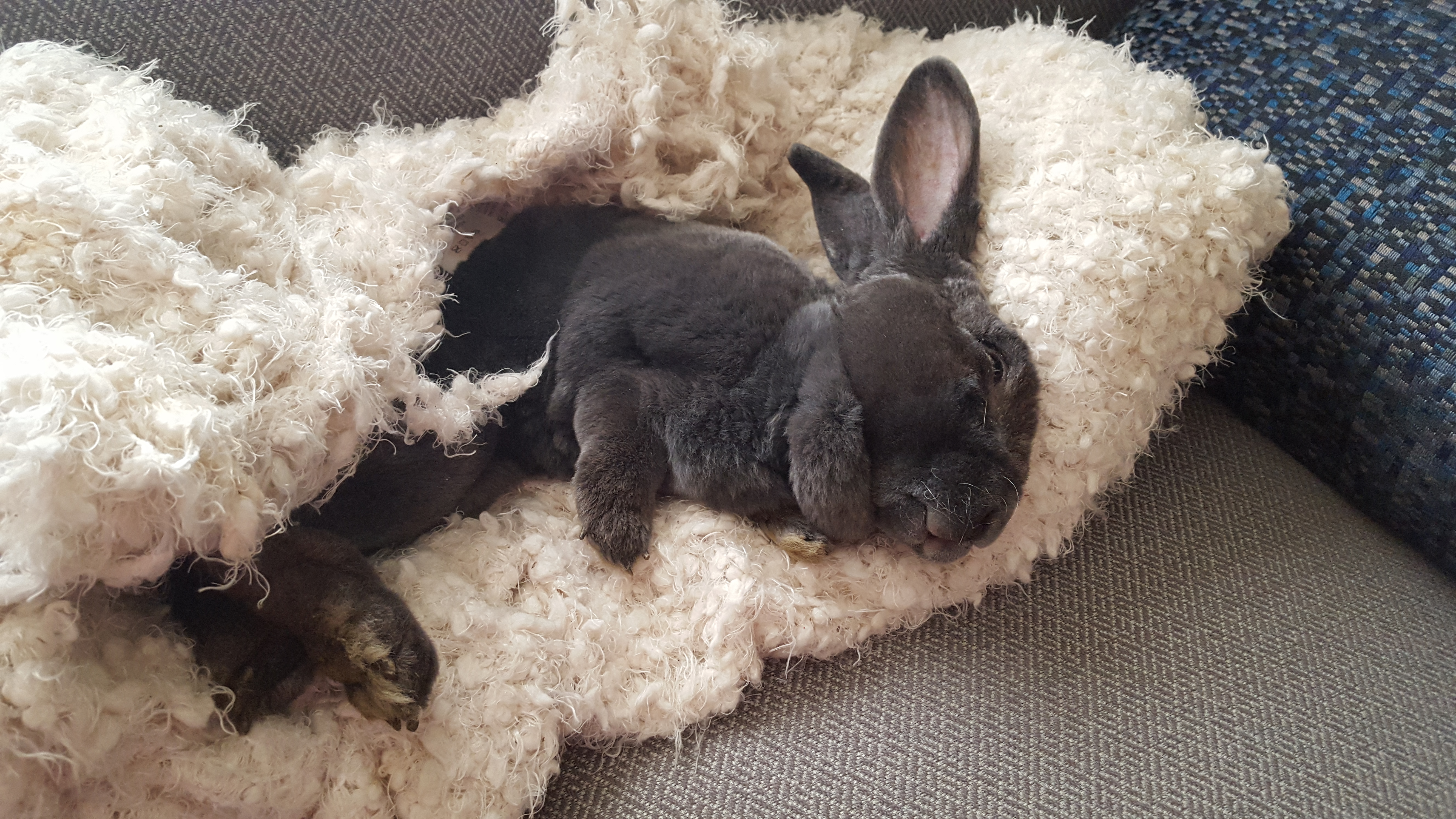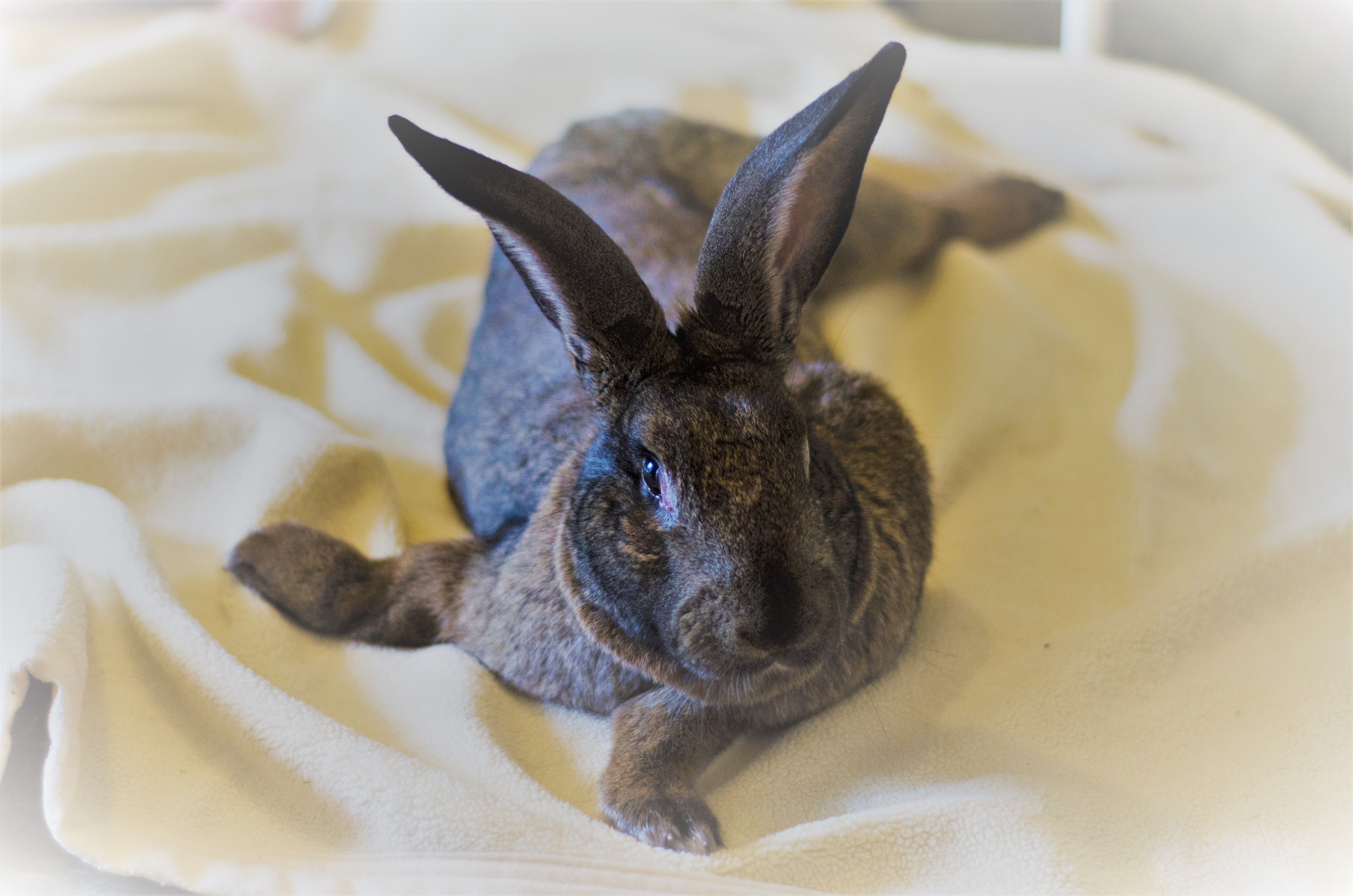
Sometimes I put a fleecy blanket on top of the water-proof layer, then top it off with the fake sheep skin. This makes the bedding even more absorbent.
Robbie is partially immobile. He scoots using his one good back leg and his one front leg that isn’t splayed, so I have him in a large area surrounded by x-pens. But because he pushes himself forward off his back leg, which has grown muscular and powerful over time, the bedding bunched up, sometimes leaving him directly on the rubber mat.

I solved the problem by cutting strips intermittently along the edges of the cloth, which I tie to the lower x-pen rungs. This way, he can move as much as he likes, but the bedding stays in place.
Clean Bum
Because they can’t reach around to clean their hindquarters, immobile bunnies depend on you to do it for them.
There are several ways to do this. I’m going describe three that I’ve used successfully over the years, and a few techniques that other caretakers use.
Before I begin, however, it’s important to know if you decide to give your bunny a bath, only wash her butt. Never give a rabbit a full-body bath. This can be such a traumatic experience it can send her into shock (and shock can kill a rabbit).
Here’s a site with a great video (with Amy Sedaris!) on why you shouldn’t give your bunny a full-body bath, and how to give a her a sitz bath, instead.
http://rabbit.org/do-rabbits-need-to-be-bathed/
Sitz Baths
Put a rubber pad on the bottom of the kitchen sink and place a towel on the edge of it. Put in enough lukewarm water to cover his backend. Lower him into the water, supporting his hind quarters. Place his front paws on the towel on the edge of the sink, while you talk to him to keep him calm.
Gently lather the shampoo into any areas that are dirty.
I recommend a mild shampoo, especially one that’s antibacterial and anti-fungal. The shampoo loosens the caked-on poop, which allows you to gently pull it off.
After drying bunny with a towel and hair dryer, I rub diaper rash cream on her butt as another preventative measure to prevent urine burn.
While sitz baths work for most bunnies, they can’t be used for the giants: Flemish Giants; English Lops; French Lops; Checkered Giants; Giant Chinchillas; and the biggest of them all, the Continentals. A kitchen sink just isn’t large enough to accommodate these big guys!
Unless you have a large sink, I’ve found that using the bathtub is a better option for them.
Shaving
Another option is to shave your bunny’s butt, which makes it easier to keep clean. I did this with Chloe, and old arthritic bunny who didn’t move from her sitting spot, which was right where she peed. She despised baths, so to make them easier and quicker, I shaved her butt. She still disliked baths, but she tolerated them better. What can you expect from a cranky old lady?
Diapers
Some caretakers use diapers on their partially immobile bunnies to give them more freedom to move outside their area. Below is a step-by-step description of how to use a diaper on your bunny.
To diaper the bunny, you:
- Cut a 1-inch slit in the middle of the center corner of an unfolded diaper. This creates a slit for the bunny’s tail.
- Put a towel on a table.
- Place your rabbit on the towel, belly-side down, facing away from you.
- Open the diaper and wrap it through your rabbit’s back legs.
- Pull your bunny’s tail through the slit.
- Wrap the diaper snugly as high as it will go around your rabbit.
I haven’t had much success with diapers, the main reason being the cecotropes.
Cecotropes
As jobs go in taking care of your special-needs rabbit, this probably falls in the category of “Less-than-Pleasant.” It’s a true labor of love, but it’s essential.
I’m referring to feeding your bunny her cecotropes. If she can’t reach around to eat them, you need to collect the cecotropes to place in front of her, so she can eat them.
Because rabbits don’t get all the nutrients from their food the first time around, they produce grape-like clusters of small, dark pellets covered in a protein-rich membrane, which they eat. The pellets also have a distinct, pungent odor.
These are cecotropes. And because the nutrients are in the membranes, do your best not to break them when you handle them.
Here’s why diapers don’t work for my rabbits and me: There’s was no way for me to get to their cecotropes. Not only couldn’t I collect them, but because they’re soft, they turned into a sticky mush that stuck to my bunnies’ butts.
Reliable Resources
As always, there are a lot of resources about how to deal with incontinence in special-needs companion bunnies. Here are some that I find useful.
Sites
http://www.mybunny.org/info/caring-for-the-partially-disabled-rabbit/
http://www.rabbit.org/journal/1/critically-ill.html
http://www.rabbit.org/journal/3-2/disabled.html
http://rabbit.org/the-dangers-of-giving-a-rabbit-a-bath/
http://rabbit.org/do-rabbits-need-to-be-bathed/
Books
Harriman, M., “House Rabbit Handbook,” Drollery Press
Moore, L.C., and Smith, K., “When Your Rabbit Needs Special Care,” Santa Monica Press, 2008
Harriman, M., “Assisted Living for Special-Needs Bunnies,” Drollery Press, 2017
The Most Reliable Resource
As always, by far the best source of knowledge is your companion rabbit. A rabbit-savvy veterinary specialist is your first call when sores or other complications do arise.
I recommend that you do refer to books, sites, and Facebook groups (be very cautious about “hobby vets” – the people on groups that love to give out inaccurate medical information), but remember that each bunny is an individual with his own special needs.
Watch your rabbit companion. And listen to him.
In last week’s blog, I introduced you to Robbie and Mr. Gilbert, two of my immobile rabbits, and Cassie, another of my rabbits, who has a congenital disorder. I used them to illustrate some of the concerns I’ve faced as a special-needs bunny caretaker.
In this blog, I’m using Robbie and Mr. Gilbert as examples of a how I, and other caretakers, deal with a major problem concerning immobile bunnies: Incontinence.
Whether your special-needs bunny is partially or completely immobile, keeping bunny’s hindquarters and living area clean is essential.
Clean Living Area
Because neither Robbie nor Mr. Gilbert can use a litter box, they pee and poop whenever and wherever. This means picking up their poop, which, as anyone who lives with rabbits knows, is a never-ending job.
It also means preventing urine scald. Because an immobile rabbit can’t project her urine away from her body, she may end up laying in it. This can cause urine scald (also called urine burn).
To keep Robbie and Gilbert’s bedding dry from pee, I use synthetic sheepskin over water-proof material, like rubber mats. The fake sheepskin is absorbent, and draws the pee down to the bottom, keeping bunny dry. And because it’s soft, it also helps prevent sores.





